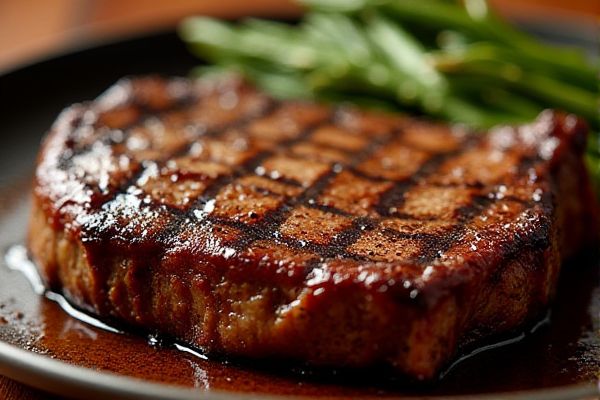
Ribeye Steak from Outback Steakhouse features a juicy, marbled cut of premium beef, seasoned to perfection and grilled to your desired doneness, delivering a tender, flavorful experience with a charred, savory crust.
Equipments
- Grill or Broiler
- Meat Thermometer
- Tongs
- Chef’s Knife
- Cutting Board
- Mixing Bowl (for seasoning)
- Small Brush (optional, for oil)
- Plate (for resting steak)
- Aluminum Foil (for resting)
Ingredients
- 1 ribeye steak (about 12 oz or 340g, bone-in or boneless)
- 1 tablespoon canola oil
- 1 teaspoon kosher salt
- 1/2 teaspoon freshly ground black pepper
- 1/4 teaspoon garlic powder
- 1/4 teaspoon onion powder
- 1/4 teaspoon smoked paprika
The ribeye steak should be about 12 oz (340g) and can be bone-in or boneless depending on your preference, with its marbling crucial for juiciness and flavor. Use canola oil to lightly coat the steak before seasoning, which helps the spices adhere and promotes a nice sear. Kosher salt, black pepper, garlic powder, onion powder, and smoked paprika blend to create a savory crust with balanced seasoning. A meat thermometer is essential to achieve your desired doneness without overcooking. This lineup ensures your homemade Ribeye Steak from Outback Steakhouse copycat menu matches the tender, flavorful experience of the original.
Instructions
- Preheat grill or broiler to high heat (450–500°F / 230–260°C).
- Pat ribeye steak dry with paper towels.
- Brush steak lightly with canola oil on both sides.
- In mixing bowl, combine kosher salt, black pepper, garlic powder, onion powder, and smoked paprika.
- Evenly season both sides of the steak with the seasoning blend.
- Place steak on hot grill or under broiler.
- Grill (or broil) for 4–5 minutes per side for medium-rare doneness, adjusting time for preferred doneness.
- Use meat thermometer to check for desired internal temperature (e.g. 130–135°F / 54–57°C for medium-rare).
- Remove steak from heat and place on plate.
- Tent loosely with aluminum foil and rest for 5 minutes.
- Slice with chef’s knife across the grain before serving.
Substitution
Ribeye Steak from Outback Steakhouse copycat menus deliver a rich, juicy flavor similar to the original by using well-marbled beef and a simple, balanced seasoning blend. If you don't have a grill, broiling in the oven is a great alternative that still achieves a seared crust. Using a meat thermometer ensures your steak reaches the perfect doneness without guessing. When seasoning, mix the spices in a bowl to evenly coat your steak, enhancing flavor consistency. Allow your steak to rest on a plate tented with aluminum foil to keep it juicy before serving.
Tips
Make sure to pat the ribeye steak dry before seasoning to help the spices adhere better and promote a good crust during grilling. Use a meat thermometer to accurately check the internal temperature, aiming for 130-135degF (54-57degC) for medium-rare doneness, avoiding the guesswork. Resting the steak tented with foil for 5 minutes allows the juices to redistribute, ensuring a juicy, tender bite. When slicing, cut across the grain to maximize tenderness and enhance your overall eating experience.
Nutritions
Ribeye steak is a rich source of high-quality protein and essential nutrients like iron, zinc, and vitamin B12, which support muscle growth and overall health. A 12 oz serving typically contains around 800 calories, with a significant portion coming from healthy fats due to the marbling in the meat. The seasoning blend adds negligible calories while enhancing flavor without extra sodium or preservatives. You can enjoy this steak as a nutrient-dense option that provides energy and supports your bodily functions.
Storage
To store your ribeye steak from Outback Steakhouse, wrap it tightly in aluminum foil or place it in an airtight container to maintain freshness. Refrigerate the steak at 34-40degF (1-4degC) and consume it within 3-4 days for optimal flavor and safety. For longer storage, freeze the steak in a vacuum-sealed bag or heavy-duty freezer wrap, where it can last up to 6 months without compromising quality.
Variation or Alternatives
You can substitute canola oil with avocado or grapeseed oil for a higher smoke point and subtle flavor enhancement. To intensify the smoky taste, consider adding a small amount of liquid smoke or using smoked sea salt in the seasoning blend. For a more aromatic profile, infuse the steak with fresh rosemary or thyme by placing sprigs on top while grilling or broiling. Using a cast iron skillet on the stovetop instead of a grill or broiler can provide a consistent sear and better control over cooking temperature.
Allergies
Ribeye Steak from Outback Steakhouse contains potential allergens such as black pepper and garlic powder, which may trigger reactions in sensitive individuals. The use of canola oil, derived from rapeseed, can also be a concern for those with specific seed allergies. You should inform your server about any allergies before ordering to ensure your meal is safe and enjoyable.
Why this recipe?
Ribeye Steak from Outback Steakhouse is renowned for its rich marbling and tender texture, delivering exceptional flavor with every bite. The steak is expertly seasoned and seared to lock in juices, providing a savory and satisfying dining experience. You can recreate this iconic menu item at home to enjoy the bold, juicy flavors that make it a standout choice among steak lovers. Perfecting a copycat Ribeye allows you to bring the essence of Outback Steakhouse's quality and taste directly to your kitchen.
